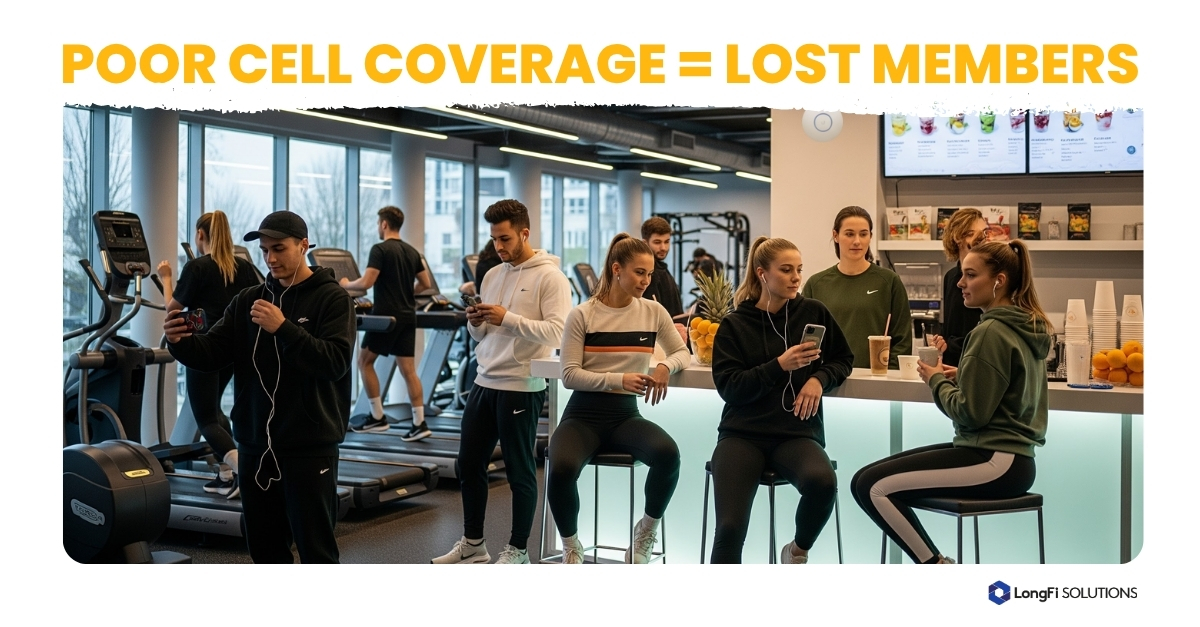Inside every modern gym, phones lift, run, and sweat right alongside their owners. They log reps. Stream playlists. Sync fitness apps. Check form videos between sets. Post proof to Instagram. The phone isn’t in the locker anymore. It’s on the treadmill, in the weight room, at the smoothie bar.
But here’s the problem nobody’s talking about: the same concrete and steel that makes your gym solid is killing cell signals. Dead zones in cardio areas. Locker rooms where apps freeze. Check-in apps that won’t load.
A member walks in. Opens their app to scan the QR code. Spinning wheel. Nothing. They try again. Still nothing. They look at the front desk person and shrug. Annoyed. That’s not a tech problem. That’s a retention problem.
The Workout Changed. Your WiFi Didn’t.
Modern gyms aren’t just squat racks and spin bikes anymore. Your members are signing up, renewing, and upgrading memberships on their phones. They’re checking in with apps, not keycards. Following workout routines from TikTok trainers in real-time. Filming their PRs for social media. Paying for smoothies and supplements with Apple Pay.
Here’s the stat that should wake up every gym owner: 36% of Gen Z are exercising regularly, and 71% of them are using a fitness influencer’s digital platform inside your club. Not at home. Inside your gym. Their phone is their personal trainer now. And when the signal drops? The workout stops. They don’t blame AT&T. They blame you.
The Part Where Most Gyms Waste Money
Most gym owners see the dead zone problem and do what seems obvious: buy signal boosters. Expensive boxes that patch one corner while another goes dark. It’s whack-a-mole.
But here’s what they’re missing: the WiFi network is already there.
You’re already paying for it. It’s already installed. Access points in every zone. The question isn’t “how do we get better signal?” The question is “how do we use what we already have?”
WiFi Carrier Offloading: The Tech That Actually Makes Sense
Here’s how it works in plain English: Carriers like AT&T and T-Mobile can route cell phone traffic from their cell towers to your secure Guest WiFi network inside your gym. Your members’ phones connect automatically. No Guest WiFi passwords. No pop-ups. No “Click here to accept terms.” It just works.
The tech behind it is called Passpoint® — a WiFi Alliance standard that lets phones recognize and join trusted networks invisibly. For your members, it feels like perfect cell coverage everywhere. For you, it’s called WiFi Carrier Offloading. And here’s the part that changes everything: carriers pay you for it.
What This Looks Like in Real Life
Member walks into your gym. Their phone automatically connects to your WiFi through the carrier network. They scan in at the kiosk. Instant. They pull up their workout from their trainer’s app. Loads immediately. They film a set for Instagram in the weight room. Uploads while they’re chalking up for the next set. They order a protein shake on their phone at the smoothie bar. Apple Pay works.
Locker room, cardio zone, functional fitness area — full coverage everywhere. No complaints. No “the app won’t work” conversations at the front desk. Just seamless Indoor Cellular Coverage that works like members expect it to.
Why This Fits Your Gym
Zero construction. You’re using the access points already installed. Zero capital expense. No hardware to buy. Carrier-backed. AT&T and T-Mobile power the network. Revenue positive. Your WiFi goes from cost center to income stream. Member experience. Fewer complaints. Higher satisfaction. Better retention.
The Bottom Line
Gyms aren’t just about barbells anymore. They’re lifestyle hubs where a dead phone kills a workout faster than forgetting your headphones. Connectivity is now as essential as air conditioning.
With LongFi’s WiFi Carrier Offloading, you solve the coverage problem, improve the member experience, and generate recurring revenue — all with infrastructure you already own. Your members keep their phones working. Carriers keep their networks efficient. You keep the revenue flowing.
That’s not a tech upgrade. That’s a business model built for how people actually work out in 2025.

